.
Some recent e-mail exchanges had me wondering about the Skylab 3 incident that was promoted on Paul Kimball’s top ten UFO events film. Those writing about the incident give us a one-sided interpretation of what was reported. Discussions with James Oberg revealed that there are some things that were not considered.
The incident
On September 20, 1973, at approximately 1645 GMT, the Skylab 3 astronaut crew was in the wardroom of the station and noticed a bright red “satellite” visible through the window. According to the crew’s initial comments to CAPCOM, at 2106 GMT, they had seen a “huge” satellite a few orbits before. Jack Lousma stated, “...it was reflecting in red light, and oscillating at, oh, considering its period of brightest to dimmest, about ten seconds. It led us into sunset...” 1 Owen Garriot took four photographs of the object and that was the end of the story until the debriefing a few weeks later.
During the debriefing, the story changed. The crew now stated that the object went into shadow after Skylab by five seconds or so indicating the object was trailing the space station.2 This is the story that has been repeated by the UFOlogists but is it accurate?
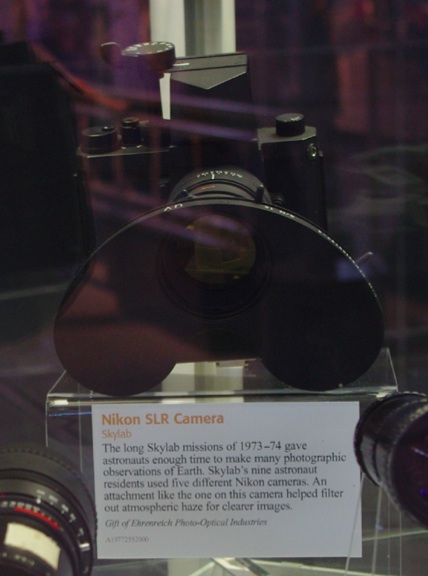
The photographs
There were four photographs of the UFO, which were taken by Owen Garriot. He used a Nikon F camera specifically designed for use on the station.3 The camera had two lenses. One was a 55mm and the other was a 300mm. The camera was a manual type where the as- tronaut would adjust the aperture settings and exposure time based on the light meter visible in the viewfinder. Exposure time could be as fast as 1/1000th of a second and as slow as 1 second. There was also a “T” setting, which is the same thing as the “bulb” setting found on most cameras. The camera also had a motor drive to advance the film but it could also be advanced manually.
The exact exposure time and lens used is difficult to determine since it was apparently not recorded on the data sheet for the photographs. Brad Sparks and Bruce Maccabee assume the photographs were tak- en using a 300mm telephoto lens and a 1/500th second shutter speed because that was the shutter speed setting for photographs preced- ing the event. 4 However, as a photographer, I disagree with this con- clusion.
Any experienced photographer (the astronauts were not amateurs and were trained in photography), would recognize photographing an object in darkness would mean that a longer exposure time would be required. Under these conditions, the light meter in the camera would be unable to compute an accurate exposure time based on a point source of light. This means the astronaut would have relied upon their experience/knowledge to select the shutter speed. If I were photographing such an object with a film camera, I would have tak- en several images using a range of exposures with the aperture wide open. This would especially be true if I were using a telephoto lens.
Since we don’t know the actual exposure time or lens, we have to as- sume that Garriot would have attempted to use a specific exposure time and then bracketed that exposure time. There seems to be evidence of this since one of the photographs (2140) appears to be underexposed, where the light is barely recorded on the film. The other images show varying brightness for the object.5 The one image that is the prize for UFO proponents is the last image
(2141). It shows an interestingly shaped object that looks like a squiggly line (see next page).
Image 2141
In my opinion, this image is the result of photographing a point source with a long exposure time. The action of pressing the shutter and trying to keep the camera still during the exposure resulted in the resultant “squiggle”. Maccabee disagrees because he feels that the effects of weightlessness and the use of a short exposure time would have prevented such an effect. One can not conclude that Garriot used the same exposure time as the previous daylight image without better evidence. Such a conclusion as- sumes that Garriot was nothing more than an amateur shutterbug that did not think about what he was photographing. If he did try and compensate for photographing a point source in darkness, he would have shot the photographs using much longer shutter times than 1/500th of a second. As a result, the potential for induced vibration by the operator pressing the shutter or not holding
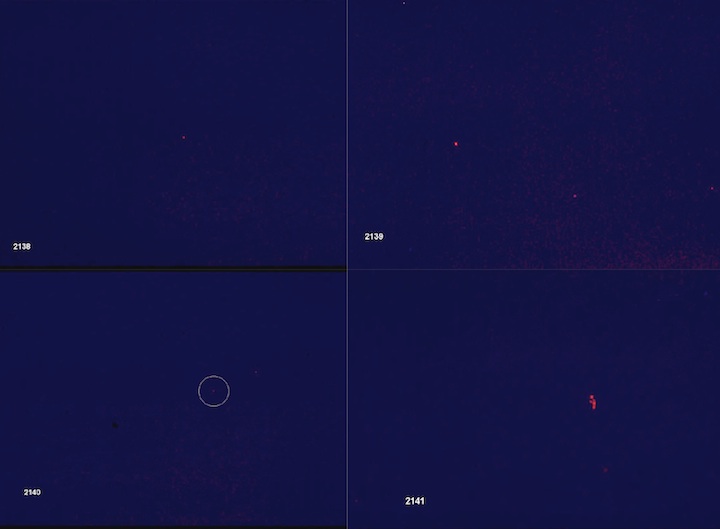
the camera still would be possible.
While discussing this with James Oberg, he presented me with an image taken from the space station showing a similar “squiggle” photograph of a point source.6

In an effort to duplicate the results of the camera with a bright point source, I used my Nikon D5000, with a 180mm fixed focal length lens, to take photographs of the planet Mars (about magnitude -1.8). In an attempt to duplicate the equipment used, I stopped the lens down to 5.6 (the normal f-stop for a 300mm telephoto lens) and set the ISO to 200. I hand-held the camera but attempted to hold it steady by propping my elbows on a fixed surface. Despite this extra effort, I still induced motion on several photographs. The results can be seen on the page. The top image shows Mars under vary exposure settings from 1/250th to 1/8th of a second exposure. The planet exhibited vibration from pressing the shutter button starting at 1/30th of a second. The motion was easily noticeable at 1/15th and 1/8th of a second. Interestingly, the image is a point source in the faster exposures but faint, requiring the arrows, just like the Garriot photos.

On the next page are cropped sections (no zoom) of three 1/8th of a second exposures of the planet Jupiter (taken in twilight) and Mars. The resultant “squiggles” are indicative of how camera motion can produce a variety of shapes/lines when using long expo- sure times. I tried to keep my arms steady on all of these shots but I have never been very successful in taking hand-held images at 1/8th of a second. I don’t think it would matter if it were a weightless environment since the action of a pressing the shutter button and the resultant motion of the mirror during the exposure would still induce some blur.

James Oberg’s statements
On Robert Sheaffer’s web site, he has commentary by James Oberg regarding the Skylab 3 UFO. After describing the case, Oberg states:
Within the past two years I’ve met face-to-face with Garriott and Lousma, for other purposes, but discussed the sighting with them. I’ve also discussed it by phone with Bean [who lives in Houston, but I’m not a frequent visitor at his home studio], but read his book’s account of the sighting. I first met these men in the 1970s when I went to work at the Johnson Space Center, and have stayed in touch over the years. To my knowledge, neither Maccabee nor Sparks has ever contacted them directly.
The interpretation of the object’s dimming at sunset at a different time than Skylab dimmed, as an indicator of the object’s actual large range, is flawed on two counts. First, the interpretation requires assumptions of the object’s altitude and other orbital characteristics that are merely convenient guesses and cannot otherwise be corroborated. Second, the assumption that there is no other possible explana- tion for the difference in dimming time than large physical separation showing up as different sunset times, is incomplete.
There is another common illumination phenomenon that allows objects near a space vehicle to move into or out of sunlight, that is to- tally independent of orbital sunrise/sunset. That is shadowing by the observing spacecraft, an optical phenomenon seen on some space shuttle TV downlinks of water dumps and views of other small drifting nearby objects shed by the shuttle. This alternative explanation was not, as best I recall, discussed or eliminated by Maccabee and Sparks.
The prosaic explanation of the dot as a nearby Skylab-shed piece of debris is supported by three arguments:
1. Similar Skylab-shed small debris was observed on all three Skylab missions, mostly as dots transiting the solar disk during observations using the station’s solar telescope.
2. The wardroom window through which this particular object was observed was on the down-sun side of the station, and during the sunset phase of each orbit the station was casting an invisible umbra extending hundreds of meters down-sun. Because the station had already crossed the Earth’s terminator, the surface below was in darkness and hence not reflecting sunlight back up into this shadow zone [as happens during most of every daylight pass] so anything in that zone would not be illuminated and would not be visible. Something moving near the station -- originally away from it but quickly into a possible parallel or closing path -- could move from sunlight into this zone and appear to vanish.
3. The long duration of the observation, measured in minutes, eliminates the possibility of it being an independent satellite in any differ- ent orbit. This is because satellites in crossing orbits have such high relative velocity that the angular velocity is too large even for most eyeball detection, much less minutes of patient watching. Note that here I am conceding Maccabee’s argument from the Gemini-11 case that the ‘UFO’ could not have been the Soviet ‘Proton’ satellite because it remained in visual and camera range too long [I now favor Sparks’s view that the crew observed a bundle of surplus spacewalk tools jettisoned manually a few hours earlier]. I also can report an independent search of known large satellites in orbit at that time [including classified vehicles whose orbital data was released decades later] and agree that no other independent satellite affords an explanation of the sighting. But Skylab-shed debris was never observed from the ground [too small], and not tracked.
4. Less powerful is another argument, that an object of the actual physical size postulated by Maccabee and Sparks would have been a bizarre naked-eye object of discernable angular size in the skies of Africa as it passed directly across that continent, yet to my knowledge no UFO reports remotely related in appearance, timing, or direction, have ever been found.
Considering the known visual stimuli engendered by the Skylab vehicle, the particular illumination conditions of the ‘sunset shadow’, and the unanimous testimony of all three witnesses as verified by three of the four photographs taken, I see no compelling case to believe the fourth image is anything but a camera or processing artifact.7
I believe that Oberg was mistaken about Maccabee/Sparks not contacting the astronauts because, in Maccabee’s article, he states
that Sparks did speak to Garriot about the incident but the best he could get from him was the fact that Garriot counted a certain way to get his time estimate correct.
The rest of Oberg’s arguments need to be considered. Probably the most interesting point he raised was that it would be impossible for the object to be trailing Skylab because the wardroom window did not normally point towards the sun. Considering the dark-
ness of the background, it seems he is correct but I wanted to make sure.
The orientation of Skylab
The Skylab station had to generate electricity using its solar panels. This required the space station to position itself so it was facing the sun:
Two precise control systems permitted the astronauts to orient the workshop to collect experimental data and to position Skylab so that its solar arrays faced the Sun.8
This image on the demonstrates how the station would orient itself during its orbit so it could photograph the Earth’s surface.9
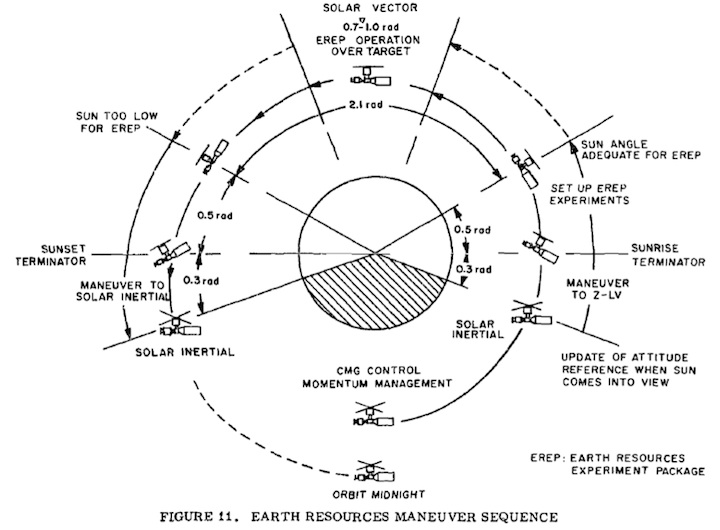
The Wardroom window’s location
One can see the various viewing window locations in the image on the next page.10 The wardroom window (#8) was on the op- posite side of the ATM. Based on what we know about the normal orientation of the craft as it passed into Earth’s shadow, it appears that Oberg is correct. The astronauts were viewing in the eastward direction and not the westward as proposed by Sparks and Maccabee. This introduces many other possibilities not considered by those, who consider this evidence of some exotic craft.
This also indicates that the statements made by the astronauts in their debriefing were incorrect as to the location of the satellite relative to the station. One has to consider the fact that the debriefing occurred roughly two weeks after the event and the potential exists they “misremembered” the details. It now appears that the statements made by the astronauts to CAPCOM just hours after the event were the most accurate.
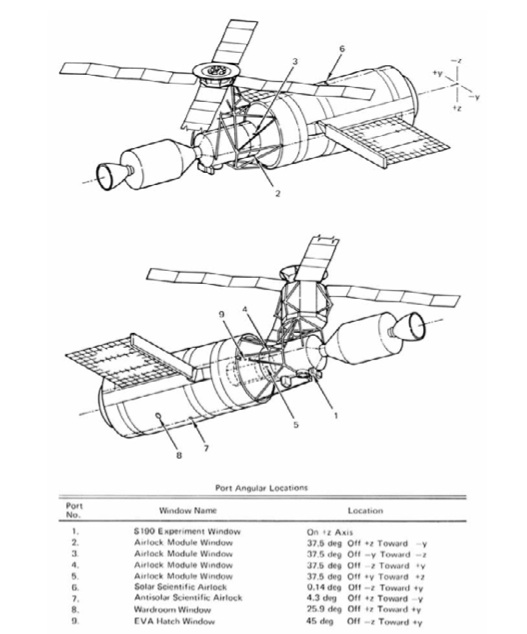
Which shadow did the object disappear into?
The disappearance of the object into shadow has always been interpreted as being the shadow of the earth. However, with the object being ahead of Skylab, another possibility exists. The space station would be casting its own shadow and it could have been what caused the object to disappear. If that was the case, the object could have been smaller and closer to the station than estimated.
A mysterious satellite?
Why wasn’t this object tracked if it was something large in orbit? The Space Detection and Tracking System (SPADATS) mon- itored everything in orbit during the 1970s. If there was some object of significant size near the Skylab space station, they would have recorded it. The same could be said for ground based observers. In this instance, the Skylab space station would have been visible to ground based observers in Africa. Nobody reported seeing a bright object moving across the sky with Skylab on that date. Since there seems to be no record of any mysterious satellite moving with the station, it indicates the object was not that large.
Space debris?
James Oberg has suggested that what was seen was space debris from the station itself. The fact that the object appears to have been pacing Skylab in a similar orbit supports that possibility. The source may have been a bit of reddish foil found on the parasol deployed by the Skylab 2 on May 26th or the second sun shade deployed by the Skylab 3 crew on August 7th. Something like that reflecting sunlight might appear red. Since the astronauts mentioned that the object was changing its location relative to the sta- tion, then the object would no longer be in position to be seen again on the following orbit.
Conclusion
The promotion of the event by UFOlogists downplayed, or ignored, the possibility the shape was due to the photographer press- ing down on the shutter mechanism while using a relatively long exposure time. They also seem to have “cherry picked” the testimony, which supports an exotic explanation instead of the testimony that supports a more prosaic answer.
While no positive identification can be made with the information available, there seems to be enough information to suggest what was seen was a piece of debris floating in a similar orbit. This is more likely than some form of exotic craft that was investigating the space station.
Quelle: SUNlite 4/2016
-
Aus dem CENAP-Archiv:
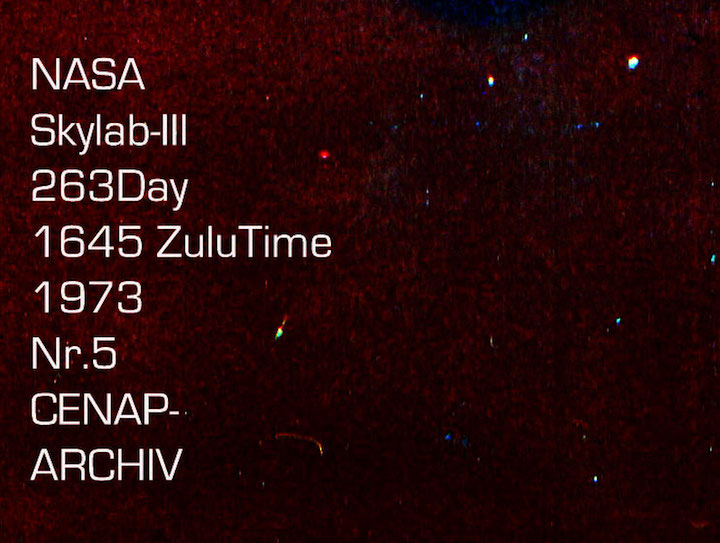
-
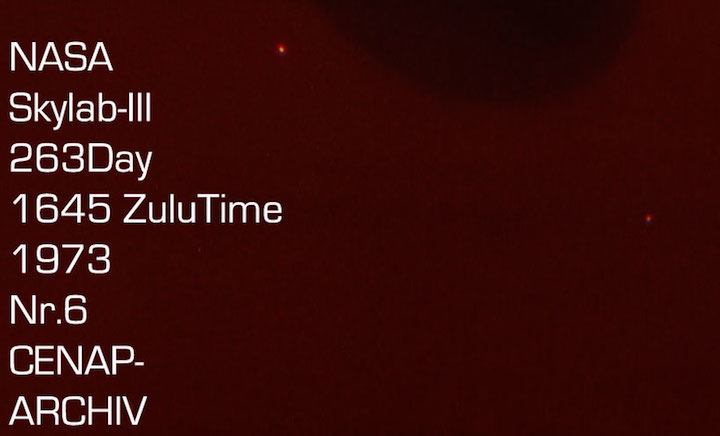
-
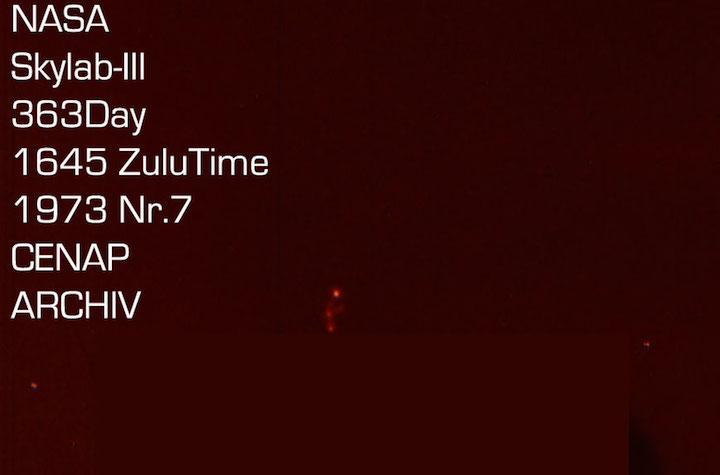
Quelle: CENAP-Archiv
